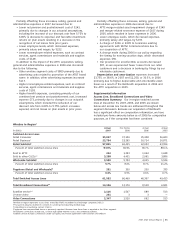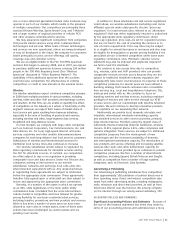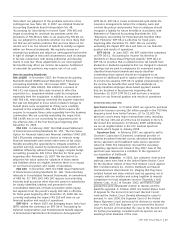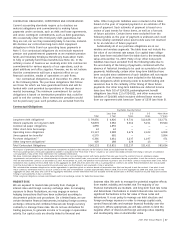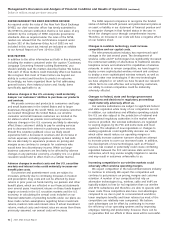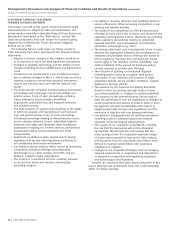AT&T Wireless 2007 Annual Report Download - page 45
Download and view the complete annual report
Please find page 45 of the 2007 AT&T Wireless annual report below. You can navigate through the pages in the report by either clicking on the pages listed below, or by using the keyword search tool below to find specific information within the annual report.
2007 AT&T Annual Report
| 43
that reflect our judgment of the probable outcome of tax
contingencies (see Note 10). In 2007, we adopted Financial
Accounting Standards Board Interpretation No. 48,
“Accounting for Uncertainty in Income Taxes” (FIN 48) and
began accounting for uncertain tax positions under the
provisions of FIN 48 (see Note 1). As required by FIN 48, we
use our judgment to determine whether it is more likely than
not that we will sustain positions that we have taken on tax
returns and, if so, the amount of benefit to initially recognize
within our financial statements. We regularly review our
uncertain tax positions and adjust our unrecognized tax benefits
in light of changes in facts and circumstances, such as changes
in tax law, interactions with taxing authorities and develop-
ments in case law. These adjustments to our unrecognized
tax benefits may affect our income tax expense. Settlement
of uncertain tax positions may require use of our cash.
New Accounting Standards
FAS 141(R) In December 2007, the Financial Accounting
Standards Board (FASB) issued Statement of Financial
Accounting Standards No. 141 (revised 2007), “Business
Combinations” (FAS 141(R)). FAS 141(R) is a revision of
FAS 141 and requires that costs incurred to effect the
acquisition (i.e., acquisition-related costs) be recognized
separately from the acquisition. In addition, in accordance
with FAS 141, restructuring costs that the acquirer expected
but was not obligated to incur, which included changes to
benefit plans, were recognized as if they were a liability
assumed at the acquisition date. FAS 141(R) requires the
acquirer to recognize those costs separately from the business
combination. We are currently evaluating the impact that
FAS 141(R) has on our accounting for acquisitions prior to
the effective date of the first fiscal year beginning after
December 15, 2008.
FAS 159 In February 2007, the FASB issued Statement
of Financial Accounting Standards No. 159, “The Fair Value
Option for Financial Assets and Financial Liabilities” (FAS 159).
FAS 159 permits companies to choose to measure many
financial instruments and certain other items at fair value,
thereby providing the opportunity to mitigate volatility in
reported earnings caused by measuring related assets and
liabilities differently without having to apply complex hedge
accounting provisions. FAS 159 is effective for fiscal years
beginning after November 15, 2007. We elected not to
adopt the fair value option for valuation of those assets
and liabilities which are eligible, therefore there is no impact
on our financial position and results of operations.
FAS 160 In December 2007, the FASB issued Statement
of Financial Accounting Standards No. 160, “Noncontrolling
Interests in Consolidated Financial Statements, an amendment
of ARB No. 51” (FAS 160). FAS 160 requires noncontrolling
interests held by parties other than the parent in subsidiaries
be clearly identified, labeled, and presented in the
consolidated statement of financial position within equity,
but separate from the parent’s equity. FAS 160 is effective
for fiscal years beginning after December 15, 2008. We are
currently evaluating the impact FAS 160 will have on our
financial position and results of operations.
EITF 06-4 In March 2007, the Emerging Issues Task Force
(EITF) ratified the consensus on EITF 06-4, “Accounting for
Deferred Compensation and Postretirement Benefit Aspects
of Endorsement Split-Dollar Life Insurance Arrangements”
(EITF 06-4). EITF 06-4 covers endorsement split-dollar life
insurance arrangements (where the company owns and
controls the policy) and provides that an employer should
recognize a liability for future benefits in accordance with
Statement of Financial Accounting Standards No. 106,
“Employers’ Accounting for Postretirement Benefits Other
Than Pensions.” EITF 06-4 is effective for fiscal years
beginning after December 15, 2007. We are currently
evaluating the impact EITF 06-4 will have on our financial
position and results of operations.
EITF 06-11 In June 2007, the EITF ratified the consensus
on EITF 06-11, “Accounting for Income Tax Benefits of
Dividends on Share-Based Payment Awards” (EITF 06-11).
EITF 06-11 provides that a realized income tax benefit from
dividends or dividend equivalents that are charged to retained
earnings and are paid to employees for nonvested equity-
classified share-based awards and equity-classified
outstanding share options should be recognized as an
increase to additional paid-in capital rather than a reduction
of income tax expense. EITF 06-11 applies prospectively to
the income tax benefits that result from dividends on
equity-classified employee share-based payment awards
that are declared in fiscal periods beginning after
December 15, 2007. EITF 06-11 will not have a material
impact on our financial position and results of operations.
OTHER BUSINESS MATTERS
Spectrum Licenses In October 2007, we agreed to purchase
spectrum licenses covering 196 million people in the 700 MHz
frequency band from Aloha Partners, L.P. for $2,500. The
spectrum covers many major metropolitan areas, including
72 of the top 100 and all of the top 10 markets in the U.S.
We closed this transaction in February 2008. Additionally,
we are an eligible bidder in the FCC wireless spectrum
auctions which began in January 2008.
Spectrum Sale In February 2007, we agreed to sell to
Clearwire Corporation (Clearwire), a national provider of
wireless broadband Internet access, education broadband
service spectrum and broadband radio service spectrum
valued at $300. The transaction received the necessary
regulatory approvals and closed in May 2007. Sale of this
spectrum was required as a condition to the approval of
our acquisition of BellSouth.
Antitrust Litigation In 2002, two consumer class-action
antitrust cases were filed in the United States District Court
for the Southern District of New York (District Court) against
SBC Communications Inc., Verizon, BellSouth and Qwest
Communications International Inc. alleging that they have
violated federal and state antitrust laws by agreeing not to
compete with one another and acting together to impede
competition for local telephone services (Twombly v. Bell
Atlantic Corp., et al.). In October 2003, the District Court
granted the joint defendants’ motion to dismiss and the
plaintiffs appealed. In October 2005, the United States Court
of Appeals for the Second Circuit Court (Second Circuit)
reversed the District Court, thereby allowing the cases to
proceed. In June 2006, the Supreme Court of the United
States (Supreme Court) announced its decision to review the
case. In May 2007, the Supreme Court reversed the Second
Circuit’s decision and remanded the case to the Second Circuit
for further proceedings consistent with its opinion; we are
awaiting formal dismissal of the case.




